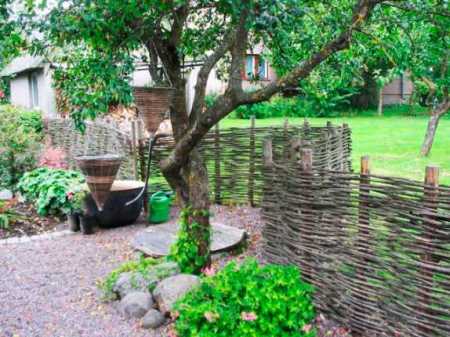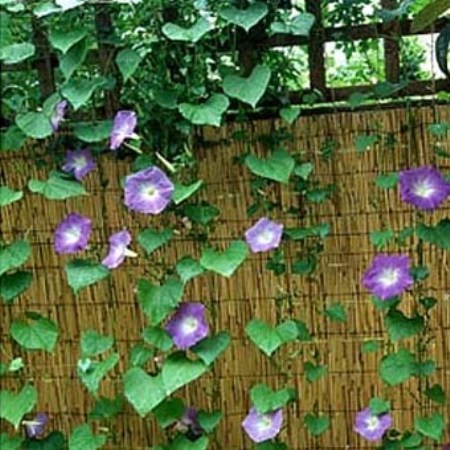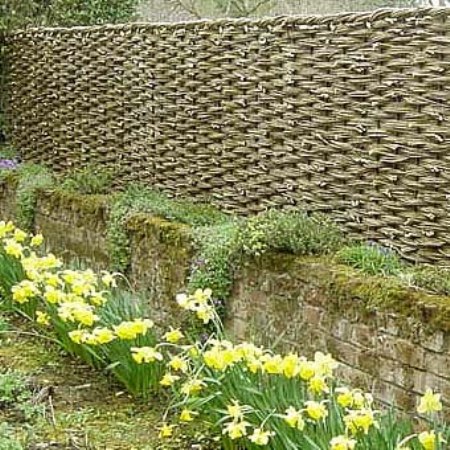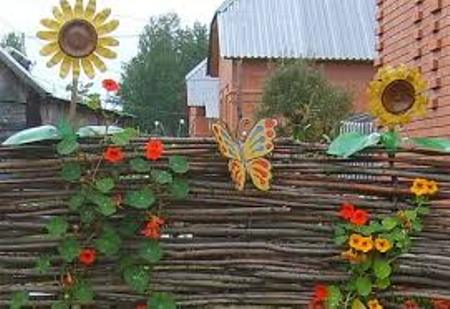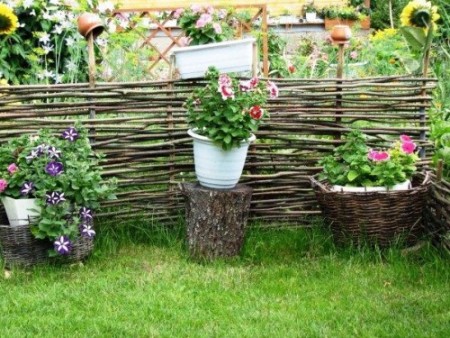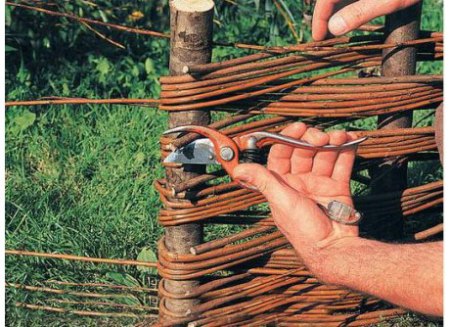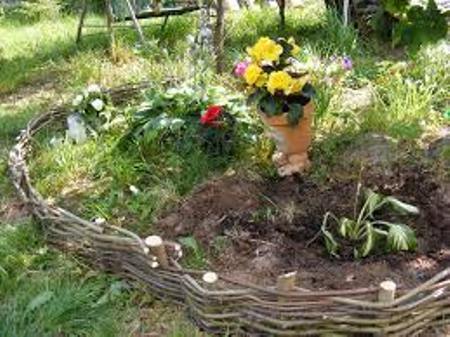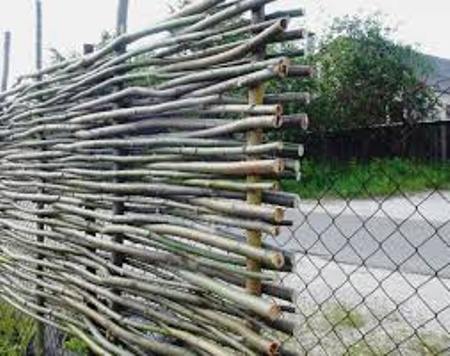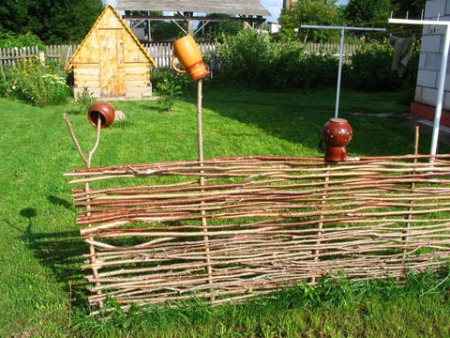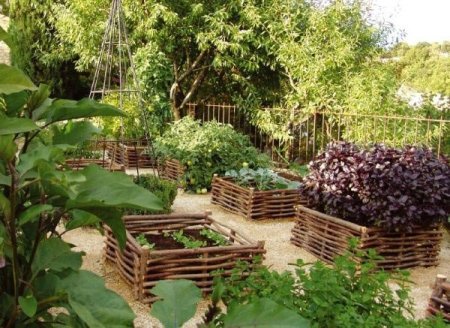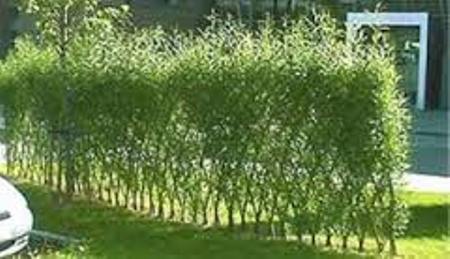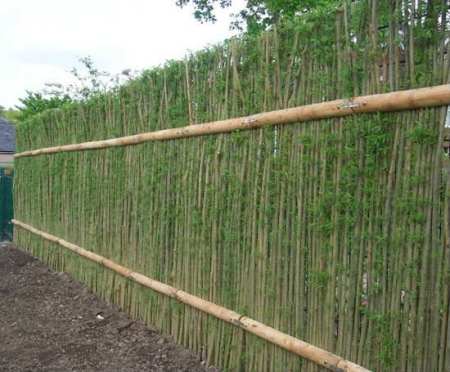In the modern world, a homestead with a house is considered one of the most convenient places for recreation. Often it is located far from the city noise and fuss. It is here that you can fully enjoy the tranquility and fresh, clean air, as well as having a great time with friends or for ever leaving in your memory picturesque, luxurious landscapes. This situation contributes not only to a full rest, but encourages the implementation of creative ideas and plans for fashionable and unusual decoration of the infield.
Content
What function can the original wicker fence play?
A piece of comfortable homestead area can rightfully be considered a made, not entirely ordinary hedge - a wattle fence. Use it to isolate and protect certain areas on the site, for example:
- a recreation area with a centrally located barbecue,
- zone, equipped for children's playground,
- zone with a suspended hammock,
- in the form of a fence for the flower bed.
In cases where the wattle is gossiped from a strong and reliable material, it can be used as a support for climbing plants. How to use the wattle fence, completely depends on the fantasies and desires of the owner. In any case, this design will always be fashionable and versatile.
Wattle with own hands
The raw material for the weaving can be harvested in a place where a large number of trees are located (forest, park, forest belt, etc.). If there are tree plantations on the territory of the household plot, the workpiece can be made from their dried branches. The main thing to remember is that pruning of dried branches should be done without fail in the winter. Only then will the tree survive the circumcision painlessly.
The manufacture of the wicker fence mainly comes from the willow vine. Also as a starting material can be used rods of apple, hazel, birch, cornelian. The basic principles of selection of the raw material are good flexibility of each of the rods, the diameter of the rod should not be less than 1 cm, the length of the rod should be not less than 50 cm.
It is interesting to look at a wicker braided from twigs of different colors, for example, when the combined colors will be contrastive to each other. Before the beginning of the weaving, the collected material is soaked in water. You can do this in a pond, a bathroom, a barrel or any other container in which you can immerse the material. Soaking will give the rods flexibility and elasticity. This stage of work can be called the least interesting, but bearing an important basic function: on how much correctly and qualitatively prepared material directly depends on the aesthetic appearance of the produced barrier.
Wicker fence
First of all, it is necessary to determine how wicker will be used:
- exclusively in the form of a decorative element,
- as a fence of zonal territory,
- carry a functional meaning.
Based on the purpose of the wattle fence, it is necessary to choose a suitable starting material. Depending on what the load on it will be imposed, the requirements may change, for decorativeness, strength, and service life. Accordingly, when choosing rods, it will also be necessary to pay more attention to the kind of twigs or strength characteristics. Since the base of the fence is made up of stakes stuck in the ground, their appearance and strength should also be given due attention.
Wattle fence in the country
If the fence is planned to be used as a fence replacing the standard fence, then there is a need to make it as reliable as possible and thereby increase the operational period. But at once the well-known fact that the tree being in moist soil is quickly recalled is quickly deformed and rotting. Proceeding from this, we can conclude: the wooden vertical bars will have to be replaced by metal ones.
Columns can be painted in color suitable for the color of harvested branches. In addition, the digging part of the columns must be treated with special anti-corrosion agents. On the bottom of the column, first of all, a primer layer is applied to protect the metal from rust, and then, after completely drying, a layer containing resin, for example, bitumen mastic. Stuck the bricks every 50 cm, along the entire length of the planned fence. The length of the dug piece can be from 0.5 m to 1 m. The pit with the inserted column is filled with gravel and poured with a cement solution, prepared in proportion of 1 part of cement and 3 parts of sand.
How to weave a wattle
Weaving can be performed classically - to place branches in the horizontal direction. 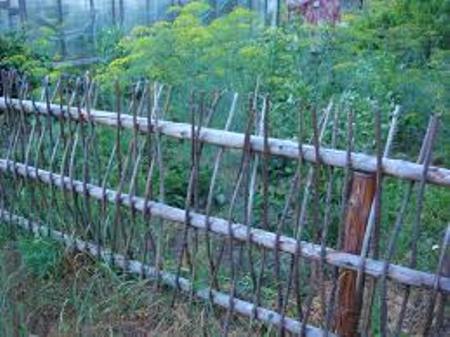
There are also variants of vertical weaving - when the branches are placed in a vertical direction, using as a basis the planks located horizontally and attached to the posts. There is also a diagonal weave. This option is used much less often than previous ones, but it looks very unusual. Diagonal weaving is performed either on the cross rails between the support posts, or on rods fixed in the ground.
How a decorative fence is made
First of all, the rods should be sorted. Separately postpone thick and straight. Of these, a frame for weaving will be assembled. The diameter of the rods at the base of the frame must be at least 3 cm. The length of the branches should exceed the height of the planned fence by at least a quarter. By treating the anticorrosive means of metal rods or tubes for posts, fixing them to the required depth and placing them at the right distance from each other, you can proceed directly to the weaving.
You need to start from the ground and slowly, slowly, carefully laying the row behind the series, move up to the top. Harvested, sorted and soaked branches are interwoven alternately between the vertical bases, if necessary, cutting off the remains. By this principle, you can make a beautiful fence of hazel, its branches are smooth and have a pleasant color. The braid is performed starting from the thick end of the rod turning to the thin one.
After the branch is finished, take another and continue the continuous weaving. It is necessary to try to evenly distribute the thin and thick ends of the rods throughout the woven construction. The lowest row should be made slightly above ground level. It will help to hold the lower bars wire, fixed to the rods-bases. In the same way, the upper branches are also fixed. An important point in weaving the fence is to observe approximately the same thickness of the structure throughout the entire length. Such control will be assisted by a periodic change in the direction of the rods, in other words, a change in the course of the weaving.
It will be interesting to look like a wicker hedge, decorated with elements of a rural decor (flower wreaths, clay pots and so on). Near such a fence, you can plant corn or sunflower, and thereby further emphasize the rural flavor.
Wicker fence
Making willow construction is the most difficult. The rods must be sorted into long (minimum 1 meter) and short (max 50 cm). The bark is removed from the rods with a knife. If this is not done, then eventually the rods will germinate. After that, the rods are stuck into the soil along the entire length of the planned hedge, at a distance of 6 to 10 cm. The rods that have a larger diameter are used as a base, and those that are thinner for the decoration of the top.
live wattle
Applying the principle of vertical weaving, you can make a living wattle fence. Make it very simple. First, dig into the ground or stick rods of support, a thickness of at least 4-5 cm, the distance between them should be of the order of one or one and a half meters. If desired, metal pipes can be used as support elements. Further with the help of more thin branches, it is necessary to perform a transverse joint. To fix the transversely arranged elements, a thin wire can be used. If the height of the supports reaches one and a half meters, then the cross connections should be carried out in two rows - above and below.
For weaving, live willow twigs are used, they are stuck into the ground to a depth of 20 cm, at a distance of 15-20 cm. When planting, they should be inclined in different directions, tk, so that it is convenient to weave. The thicker the rods are, the faster the site owners will get a hedge, hiding the territory from outside views. Through such a fence, no people or small animals can penetrate the site. It should not be forgotten that with time the rods will become thicker to create a single living organism from them, it will be necessary to make neat cuts at the places of contact between the branches and to wrap them with scotch tape.



